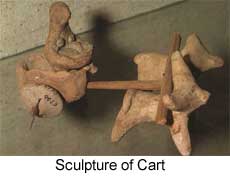

 |  |
 The discovery of statues, figurines of men and women in terracotta, stone and metal indicate that people of the area were great artists and sculptors.
The discovery of statues, figurines of men and women in terracotta, stone and metal indicate that people of the area were great artists and sculptors.Sculpture in Stone: Among the stone images found in Harappa two male statues are noteworthy. One of them is artistically decorated while the other is kept naked. The first statue is that of a yogi, draped in a shawl worn over the left shoulder and under the right arm. His beard is well-kept and his eyes are half-closed. The other figure is a torso of a human male. It is beautiful piece of sculpture made of red stone. The head and arms of the figure were carved separately and socketed into holes drilled on the torso. Sculpture in Metal: The Harappan artists knew the art of bronze casting. They used the special lost wax process in which the wax figures were covered with a coating of clay. Then the wax was melted by heating and the hollow mould thus created was filled with molten metal which took the original shape of the object. A figure of a female naked dancer was found at Mohen-jo-daro. Necklaces adorn her breast. One of her arms is fully covered with bangles made of bone or ivory. Her eyes are large, nose is flat and the lips are pendulous. Her hair is braided and her head is slightly thrown back. Her limbs suggest graceful lines. Besides the figurine, bronze figures of a buffalo and a humped bull are very artistically designed. Sculpture in Terracotta: The Indus Valley people practiced sculpture in terracotta. The teracota figure of the Mother Goddess was discovered in Mohen-jo-daro. The figure, with a punched nose and artistic ornamentation laid on the body and pressed on the figure, shows the Mother Goddess as the symbol of fertility and prosperity. Pottery and Painting: Pottery found in large quantities shows that with the potter's wheel the craftsman produced pottery of various artistic shapes. The special clay for this purpose was baked and the different designs on pots were painted. Figures of birds, animals and men were depicted on the pots. Paintings on the pots show, that these men were equally good at painting. next page >> |
Copyright ©2000 indiansaga.info. All rights reserved.
By using this service, you accept that you won't copy or use the data given in this website for any commercial purpose.
The material on indiansaga.info is for informational & educational purpose only.
This site is best viewed at 800 X 600 picture resolution.